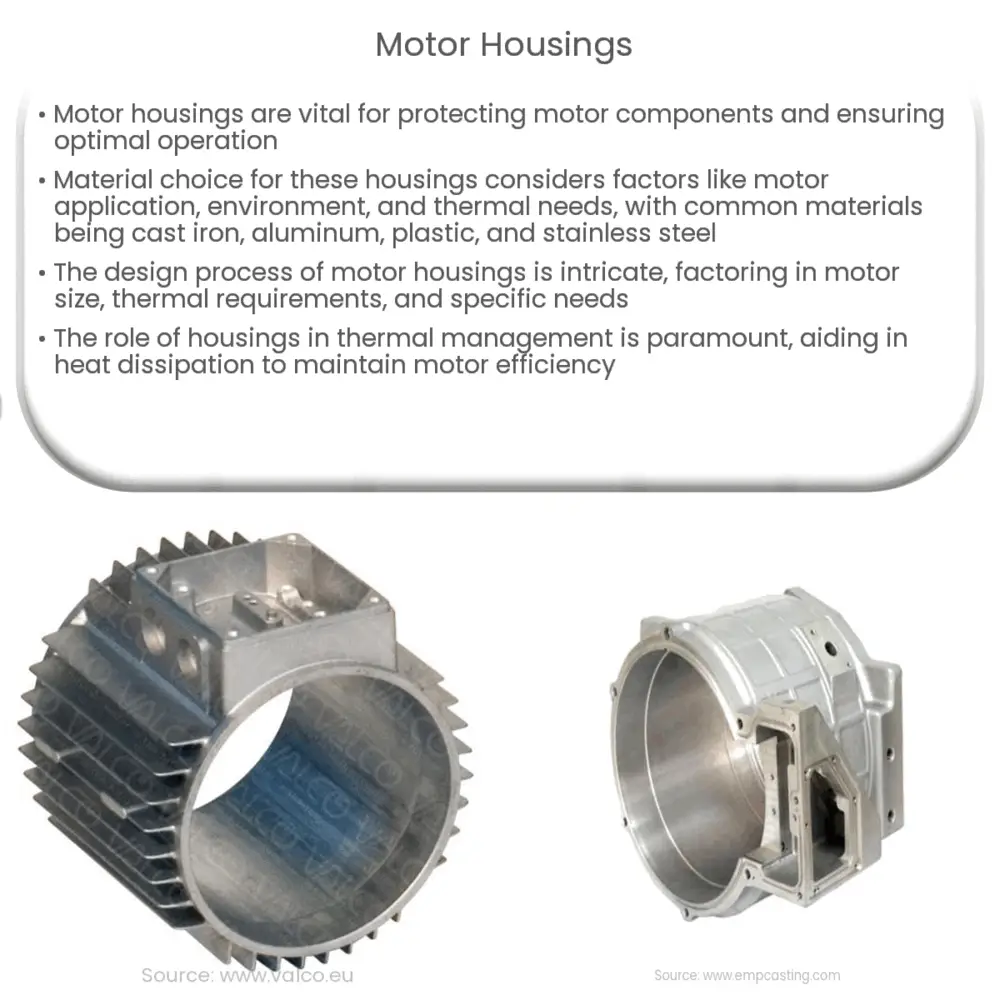Explore the vital role of motor housings, the materials used, their design, thermal management, selection factors, and future trends.

Introduction to Motor Housings
Motor housings play a crucial role in the overall operation and performance of various types of motors. Predominantly, they are designed to protect integral motor components and offer structural support. The effective functioning of a motor, whether it’s in a simple household appliance or complex industrial machinery, often depends on the quality and characteristics of its motor housing.
Materials Used in Motor Housings
The choice of material for a motor housing depends on several factors, including the specific application of the motor, the environment it operates in, and the thermal management requirements. The most common materials used include:
- Cast Iron: This is a traditional material for motor housings due to its excellent mechanical properties and thermal characteristics. However, its weight and difficulty in shaping can be limiting factors.
- Aluminum: With its superior thermal conductivity and lightweight properties, aluminum is often chosen for smaller motors and applications where weight is a concern.
- Plastic: For smaller and less powerful motors, such as those found in many household appliances, plastic housings are common. These are lightweight, economical, and can be easily molded into complex shapes.
- Stainless Steel: Used in environments where the motor is exposed to corrosive elements or high-pressure washdowns. Commonly found in food and beverage industries, pharmaceuticals, and other sterile environments.
The Design and Manufacturing Process of Motor Housings
The process of designing and manufacturing motor housings involves a series of steps. Initial design takes into account several factors, including the size and type of motor, operating conditions, thermal management requirements, and any specific customer needs. Once the design is finalized, manufacturing processes such as casting, machining, or injection molding (for plastic housings) are implemented. The manufactured motor housings then undergo rigorous testing and quality checks to ensure their durability and fit for purpose.
Role of Motor Housings in Thermal Management
One of the critical roles of a motor housing is in thermal management. During operation, motors generate heat due to electrical and mechanical losses. Proper dissipation of this heat is crucial to prevent overheating and maintain the motor’s efficiency and longevity. The material and design of the motor housing, including aspects like surface area and ventilation, play a significant role in heat dissipation.
Factors Influencing the Selection of Motor Housings
There are several factors to consider when selecting the appropriate motor housing for a specific application:
- Operating Environment: The operating conditions greatly influence the choice of motor housing. Environments with extreme temperatures, high humidity, or corrosive elements require housings made from materials that can withstand such conditions.
- Motor Type and Size: The type and size of the motor will determine the size and shape of the housing. Larger and more powerful motors typically require robust and thermally efficient housings.
- Cost: The cost of the material and manufacturing process can also influence the choice of motor housing. While some materials may offer superior performance, they may also be more expensive, influencing the overall cost of the motor.
- Weight: In certain applications, such as in automotive or aerospace, the weight of the motor housing can significantly impact the performance and efficiency of the system.
The Evolution and Future of Motor Housings
In the past, the design and choice of materials for motor housings were relatively simple, with cast iron being the dominant material. However, as motor technology has advanced and diversified, so too have the requirements for motor housings. Today, a broad range of materials and complex designs are utilized to meet the specific needs of various motor applications.
In the future, we can expect to see further advances in motor housing design and materials. Emerging technologies such as 3D printing offer exciting possibilities for creating highly customized and efficient motor housings. Additionally, the ongoing drive for energy efficiency and sustainability is likely to influence the development of new materials and design concepts.
Conclusion
In conclusion, the motor housing plays a pivotal role in the performance, durability, and efficiency of a motor. It not only protects the motor from environmental factors but also serves as an essential component in managing heat and supporting the mechanical structure of the motor. With advancements in technology, we can anticipate further developments in motor housing design, material selection, and manufacturing processes, ultimately enhancing motor performance and meeting the diverse demands of various industries.

